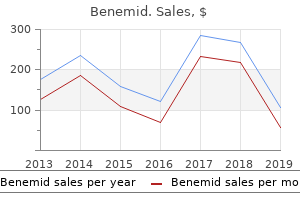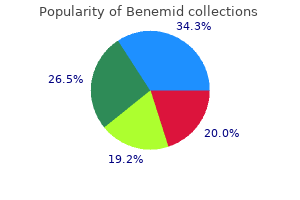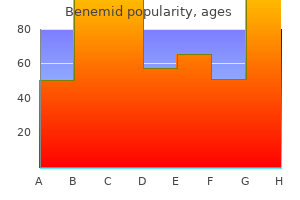Benemid
"Buy cheap benemid 500 mg online, blaustein pain treatment center hopkins".
By: V. Zakosh, M.B. B.CH. B.A.O., Ph.D.
Clinical Director, Harvard Medical School
Either by elevation or expression Expression should be avoided in the presence of venous thrombosis knee pain treatment exercises buy 500mg benemid with visa, malignancy or infection wrist pain yoga treatment effective 500 mg benemid, all of which may be spread by embolism 492 Chapter 22: Basic science oral core subjects Compartment syndrome it is a very important subject and you have to be ready to heel pain treatment plantar fasciitis buy generic benemid line clarify the mechanism clearly pain treatment center of greater washington generic benemid 500 mg fast delivery. Compartment syndrome is outlined as elevated stress in an enclosed osteofascial area resulting in decreased capillary perfusion below that necessary for sustained tissue viability. Increased content material within the compartment � haemorrhage, ischaemic swelling, reperfusion harm, and so forth. As compartment strain approaches systolic pressure, flow in to the compartment will cease. In trauma the measurement is taken inside the zone of harm and must be undertaken in all relevant compartments the edge could be an absolute value of 30 mmHg or pressure within 20�30 mmHg of diastolic blood stress � Edinburgh group. Clinical presentation A analysis of acute compartment syndrome is a surgical emergency Leg compartments � two-incision method (anterolateral and medial) is used to decompress all four compartments Forearm � volar decompression to embody carpal tunnel, then examine the dorsum and decompress if necessary Foot � a quantity of different methods have been described, relying on the part of the foot affected. Of the above, disproportionate ache, ache on passive motion and a decent compartment on palpation are an important as all the others are too late and tissues may necrose even though a pulse is still current distally At 1 hour of ischaemia, a reversible neurapraxia develops At 8 hours of ischaemia, axonotmesis occurs. Electrosurgery An electric circuit is made involving the patient, the place the affected person is the purpose of current resistance, generating heat Frequency chosen is above 100 kHz to avoid nerve and/or muscle stimulation Monopolar electrosurgery includes an lively electrode (high current density) at the surgical web site and a return electrode elsewhere on the patient. Most techniques now monitor the impedance on the return electrode to cut back burn risk Care ought to be taken with flammable prep options, which can soak in to drapes and then catch fire � alcohol burns without a visible flame Bipolar electrosurgery involves lively and return level electrodes at the surgical website. The forceps points (electrodes) should be separated for current to cross by way of tissue. Advantage of bipolar � avoids threat of damage from passage of current by way of surrounding tissues (particularly arteries in digits, and so forth. Antibiotic actions Bacteriostatic Bacteriocidal Mixed Penicillin/cephalosporins � forestall bacterial cell wall synthesis � cell wall enzyme Glycopeptides (vancomycin, teicoplanin) � intervene with cell wall enzyme Fucidin and clarithromycin � block ribosomal peptides Linezolid � inhibits protein synthesis. Infection control Two approaches are taken to tackle this issue: Reducing the size of the inoculum Enhancing the host defences. Reducing the inoculum Ward hygiene Screening/separation of contaminated cases Skin cleanliness (not antisepsis � as this encourages resistance) Theatre design and apply (see below) Limiting dressing modifications. Skin flora Includes coagulase-negative Staphylococcus epidermidis, Staphylococcus aureus and Gram-positive diphtheroid bacilli. Enhancing host defences Good diet Antibiotic prophylaxis where appropriate Tetanus prophylaxis Optimize the skin preoperatively. If discovered on screening swabs: 5 days intranasal mupirocin 4% chlorhexidine baths Re-swab and repeat if necessary. Bacteria Gram staining entails staining with crystal violet, fixing with iodine then washing with alcohol: Gram-positive retain dye; Gram-negative dye washes out and then re-stained with safranin O: Gram-positive cocci: staphylococci, streptococci Staphyloccoci may be coagulase-positive (Staph. Therapeutic index � efficient focus at site/minimum inhibitory concentration. Liddell showed discount in deep sepsis by 50% with ultraclean air techniques, an additional 25% discount with body exhaust suits, and 0. Handwashing Bacterial counts are decreased by 99% with chlorhexidine, 97% with povidone�iodine Residual effect after time 97% with chlorhexidine, 90% with iodine. Theatre clothing Cotton clothing has pore sizes of eighty microns � allow pores and skin scales to cross by way of Single use non-woven clothes with spun-laced fibres impede bacterial passage but permits air flow Gore-Tex has very small pore dimension (0. Orthotics and prosthetics Orthoses Orthoses are exterior home equipment which are used to: Correct a flexible deformity Control movement Augment weak muscle tissue Redistribute forces. The identical biomechanical rules as described for bones and joints apply to orthoses. Problems with orthotics are frequently at the orthotic�skin interface and it is important to perceive the methods in which the interface pressures may be reduced: Maximizing the lever arm of the orthotic in relation to the lever arm of the deforming pressure Maximizing the surface area via which the forces are utilized from the orthotic to the pores and skin Maximizing the conformity between the orthotic and the underlying limb/trunk Minimizing strain through unprotected bony prominences. The materials on the interface also needs to be moistureabsorbant to avoid maceration of the pores and skin. Many orthotics are produced from plastic, which can be: Thermosetting � not remouldable as soon as shaped Thermoplastic � this can be remoulded by warming. Epidemiology Risk components Age � exponential increase in risk Obesity � 3� threat Varicose veins � 1. Defining a analysis question: Who/what would be the topic of the study (inclusion and exclusion criteria) Doing a literature search to be certain that the study has not already been carried out Deciding on the dimensions of the study � this will must involve a statistician and in some circumstances a pilot research to establish the variance of the inhabitants beneath study Deciding how the data will be analysed Finding funding for the research Ensuring that patient security is ensured at all times Ensuring that moral approval is obtained Planning a publication route to disseminate the outcomes. Inferential � allows conclusions about trigger and effect, predictions about future behaviour, etc.

It passes beneath the bicipital aponeurosis on the elbow narcotic pain medication for uti order benemid 500mg on line, leaving the cubital fossa between the 2 heads of pronator teres pain medication for pregnant dogs order 500mg benemid with mastercard. It descends deep to the flexor digitorum superficialis on flexor digitorum profundus pain treatment alternative cheap 500 mg benemid with visa. It travels deep to the palmaris longus tendon and enters the carpal tunnel the place it divides in to a lateral and medial department milwaukee pain treatment center milwaukee wi discount generic benemid canada. The lateral branch offers off the recurrent (muscular) department and then breaks up in to three palmar digital nerves, two for the thumb and one for the index, the final one additionally supplying the primary lumbrical. The medial department divides in to two common palmar digital nerves for the index, center and lat ring finger and the last one also provides the second lumbrical. Palmar digital nerves supply not solely the whole palmar aspect of the finger but additionally the distal � of the dorsal side of each finger as properly. It provides all of the flexor muscular tissues of the forearm except flexor carpi ulnaris and the medial half of flexor digitorum 540 Chapter 24: Anatomy oral core matters this ends in the median nerve innervating a variable number of intrinsic muscular tissues of the hand: First dorsal interosseus: most common Others: adductor pollicis, abductor digiti minimi. Connections between deep ulnar and median nerves in hand Distal: aponeurotic arch of origin of hypothenar muscles Medial wall: pisiform and fibrous attachments of pisohamate ligament Lateral wall: hook of hamate Roof: volar carpal ligament. The ulnar nerve divides throughout the canal in to superficial (more ulnar) and deep (more radial) branches on the level of the pisiform. The canal has three segments: Proximal tunnel at the mid pisiform bone Midtunnel between pisiform bone and hook of the hamate Distal tunnel at the hook of the hamate. Spared dorsal medial hand and fingers (dorsal cutaneous branch) and proximal ulnar palm (palmar cutaneous branch). Fibrous arch overlying deep terminal (motor) branch of the ulnar nerve because it passes under flexor digiti minimi brevis at the hook of hamate. There are numerous causes of ulnar nerve compression around the elbow: bony deformities (old fractures, osteophytes, osseous fragments, osteoarthritis, rheumatoid arthritis, shallow groove, valgus deformity 2 to lateral epicondyle fracture), trauma (lacerations, adhesions), soft-tissue plenty (ganglions), muscle (medial head of triceps, anconeus epitrochlearis) and compression neuropathies (arcade of Struthers, Osborne band, and so on. Ulnar nerve (C8, T1) the ulnar nerve arises medial to the axillary artery and continues medial to the brachial artery, mendacity on coracobrachialis to the midpoint of the humerus where it leaves the anterior compartment by passing posteriorly via the medial intermuscular septum with the superior ulnar collateral artery to enter the posterior compartment of the arm. It runs anterior to the medial head of triceps, passing posterior to the medial humeral epicondyle to enter the forearm between the two heads of flexor carpi ulnaris. It passes posterior to the medial humeral epicondyle to enter the forearm between two heads of flexor carpi ulnaris. It runs deep to flexor carpi ulnaris on the flexor digitorum profundus with the ulnar artery on its lateral aspect from onethird of the way down the forearm. In the distal forearm it turns into superficially lined only by fascia and pores and skin passing superficial to the flexor retinaculum with the ulnar artery, lateral to pisiform and grooving the hook of the hamate. The deep branch of the ulnar nerve pierces between abductor digiti minimi and the flexor digiti minimi brevis. Branches of the ulnar nerve No branches within the arm Articular branches to elbow joint Flexor carpi ulnaris and medial � flexor digitorum profundus Palmar cutaneous department (skin over hypothenar eminence) Dorsal cutaneous branch (medial skin dorsum of hand and 1� digits). Superficial department of the ulnar nerve: supplies palmaris brevis and then carries on as the superficial palmar branch to innervate the palmar 1� digits Deep department of the ulnar nerve: supplies wrist joint, flexor digiti minimi, abductor digiti minimi, opponens digiti minimi, palmar and dorsal interossei, two medial lumbricals, adductor pollicis and deep head of flexor pollicis brevis. Sensation to the thumb that is provided from five branches: Lateral antebrachial cutaneous nerve Superficial and dorsal digital branches of the radial nerve Digital and palmar branches of the median nerve. Apex: bounded by clavicle, scapula and outer border of first rib Anterior wall: pectoralis main, pectoralis minor, subclavius Posterior wall: subscapularis, teres major Medial wall: higher part of serratus anterior. Action Innervation Notes Muscle Origin Insertion Anterior group muscle tissue connecting upper limb to trunk Pectoralis main Clavicle head: med. Sternocostal head: lat manubrium and sternum, upper six costal cartilages and ext. Cord) Notes Suprascapular nerve passes beneath transverse ligament of scapula Partly lined by deltoid and trapezius Often not clearly differentiated from the infraspinatus. Tendon fuses with capsule of shoulder joint Infraspinatus Teres minor Subscapularis Med. Functions embrace: Stabilizing and centralizing the humeral head towards the glenoid Concavity compression: throughout abduction of the arm, the rotator cuff compresses the glenohumeral joint to permit the deltoid to further elevate the arm. Without the rotator cuff, the humeral head would journey up partially out of the glenoid fossa, lessening the efficiency of the deltoid muscle Elevating and rotating the arm. The long head of biceps might be considered a functional a part of the rotator cuff. The examiners then interrogate you on the rotator cuff anatomy (origins, insertions, nerve supply, and so forth.

Growth of the calvarium is directly dependent on development of the instantly subadjacent dura pain treatment center american fork safe 500mg benemid. The orientation of the dural fibers is said to the position of 5 chondrocranial structures of the cranium base (both petrous crests pain treatment center of america buy 500 mg benemid visa, crista galli midsouth pain treatment center cordova tn buy benemid overnight delivery, and each lesser sphenoid wings) pain management for arthritis in dogs purchase benemid 500 mg without prescription. Calvarial bones embody frontal bones (two), parietal bones (two), a small portion of the occipital bone, and squamous parts of temporal bones (two). The coronal suture is positioned between the frontal and parietal bones, the sagittal suture between the parietal bones, the lambdoid suture between the parietal and occipital bones, and the metopic suture between the frontal bones. Junction regions the place three or extra calvarial bones meet are referred to as fontanelles. The largest is the anterior fontanelle, which is situated between the frontal and parietal bones. The different fontanelles are considerably smaller and include the posterior, posterolateral (mastoid), and anterolateral (sphenoid) fontanelles. The dimension of the calvarial portion of the cranium is dependent on progress of the intracranial contents (brain and ventricles). Patients with micro- cephalic brains have small-sized calvarial vaults, and those with enlarged brains. Premature closure of one or more sutures (craniosynostosis) results in varied deformities of the calvaria depending on which suture is concerned. Growth of the chondrocranial bones of the cranium base are much less depending on brain growth as is the calvarium. The occipital cephalocele is the most common kind within the Western hemisphere, and the frontoethmoidal type is most typical in Southeast Asia. Pathologic processes involving the skull can result by direct extension from adjacent anatomical constructions (sinusitis resulting in osteomyelitis, intracranial neoplasm or inflammation finally involving the cranium, etc. Primary pathologic conditions involving the skull embody craniosynostosis, Paget illness, trauma/ fracture, neoplasm, infection/inflammation, nonmalignant lesions (epidermoid, hemangioma, and so on. Autosomal dominant disorder (1/2500 births) representing the most common type of neurocutaneous syndromes, associated with neoplasms of the central and peripheral nervous systems and pores and skin. Most common extra-axial tumor, usually benign; sometimes occurs in adults older than age forty y; girls males. Multiple meningiomas seen with neurofibromatosis type 2; may end up in compression of adjoining brain parenchyma, encasement of arteries, and compression of dural venous sinuses; hardly ever invasive/malignant types. Sagittal (a) and coronal (b) postcontrast photographs show an enhancing meningioma alongside the olfactory groove. Single or multiple well-circumscribed or poorly defined lesions involving the cranium, dura, leptomeninges, mind, and/or choroid plexus; low to intermediate attenuation; often with contrast enhancement, with or without bone destruction, with or without compression of neural tissue or vessels. Single or a quantity of well-circumscribed or poorly outlined lesions involving the cranium, dura, and/or leptomeninges; low to intermediate attenuation; normally with distinction enhancement, with or without bone destruction. Comments Rare neoplasms in younger adults (males females) typically referred to as angioblastic meningioma or meningeal hemangiopericytoma; come up from vascular cells/pericytes; frequency of metastases meningiomas. Giant aneurysm: Focal, well-circumscribed construction with layers of low, intermediate, and excessive attenuation secondary to layers of thrombus of various ages, in addition to a contrast-enhancing patent lumen if present. Fusiform aneurysm: Elongated and ectatic arteries; variable low to intermediate attenuation. Dissecting aneurysms: the concerned arterial wall is thickened and has intermediate attenuation. Focal aneurysms are also referred to as saccular aneurysms, which typically happen at arterial bifurcations and are a number of in 20% of sufferers. Transverse, sigmoid venous sinuses cavernous sinus straight, superior sagittal sinuses. Axial postcontrast images present an enhancing disseminated subarachnoid tumor from a pineoblastoma. Decreased or absent distinction enhancement of the supraclinoid portions of the interior carotid arteries and proximal center and anterior cerebral arteries. Prominent localized unilateral leptomeningeal distinction enhancement normally in parietal and/or occipital regions in youngsters; with or with out gyral enhancement; delicate localized atrophic adjustments within the mind adjoining to the pial angioma; with or without prominent medullary and/or subependymal veins; with or without ipsilateral prominence of choroid plexus. Comments Progressive occlusive disease of the intracranial parts of the inner carotid arteries with resultant numerous dilated collateral arteries arising from the lenticulostriate and thalamoperforate arteries, as nicely as different parenchymal, leptomeningeal, and transdural arterial anastomoses. Term translated as "puff of smoke," referring to the angiographic look of the collateral arteries (lenticulostriate, thalamoperforate). Usually nonspecific etiology, but could be associated with neurofibromatosis, radiation angiopathy, atherosclerosis, and sickle cell disease; usually youngsters adults in Asia.
Discount benemid 500 mg mastercard. Impact of Bone Metastases on the Skeleton YouTube.


